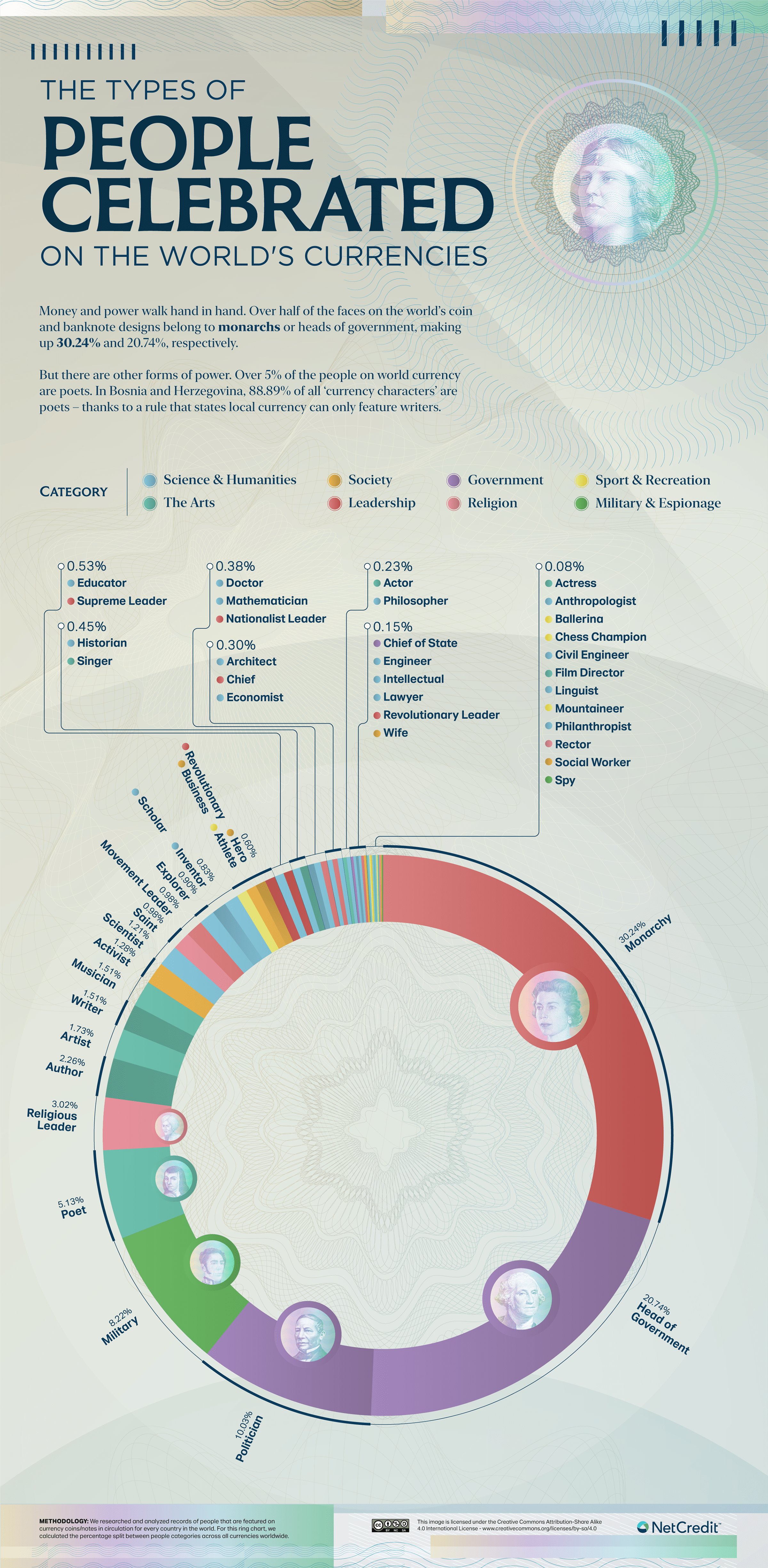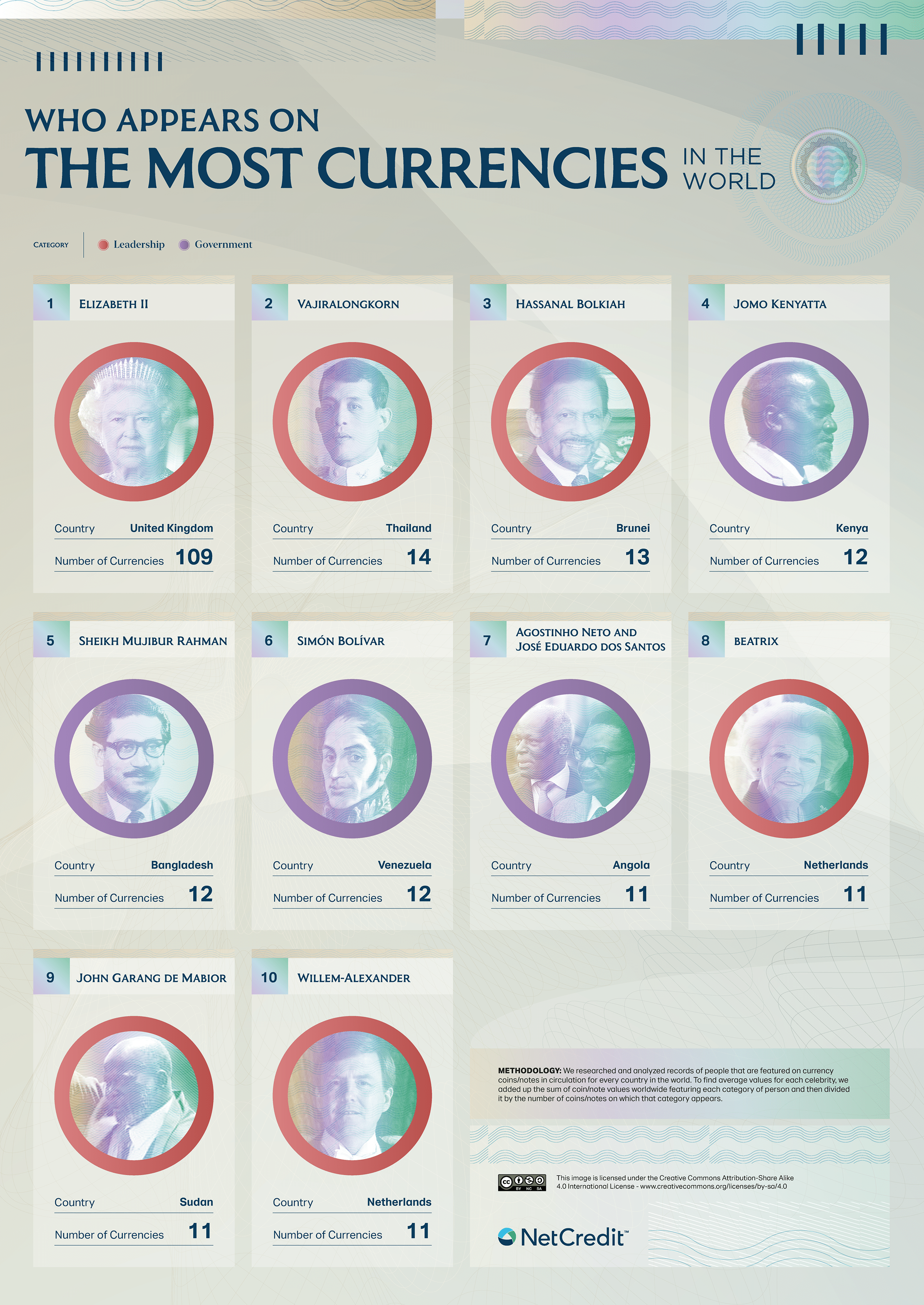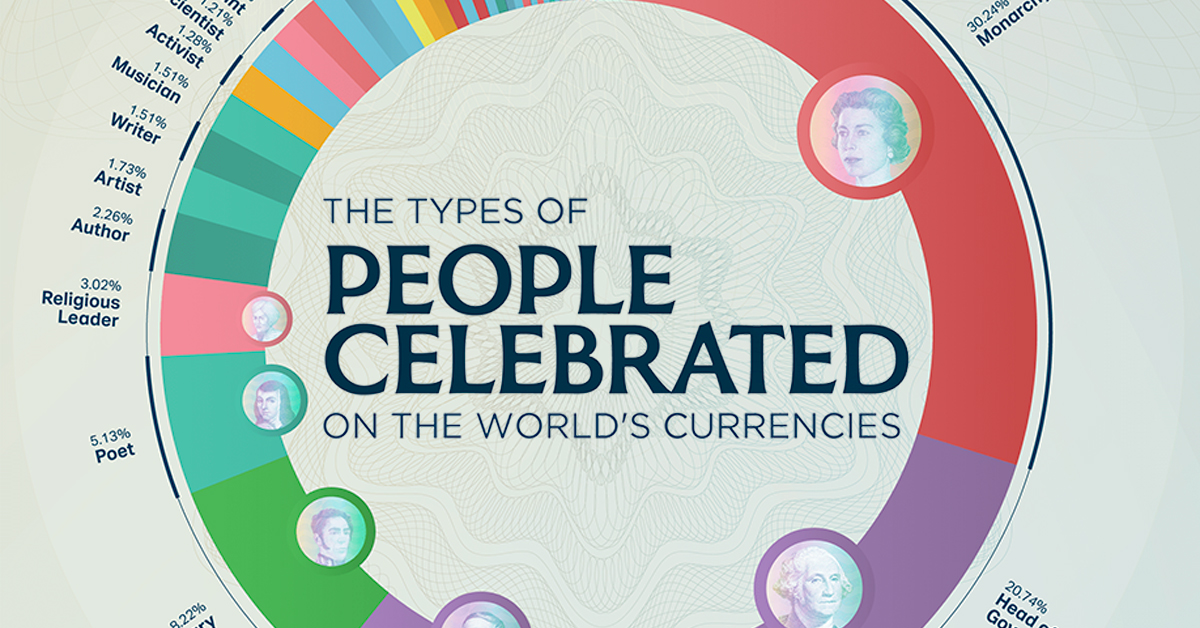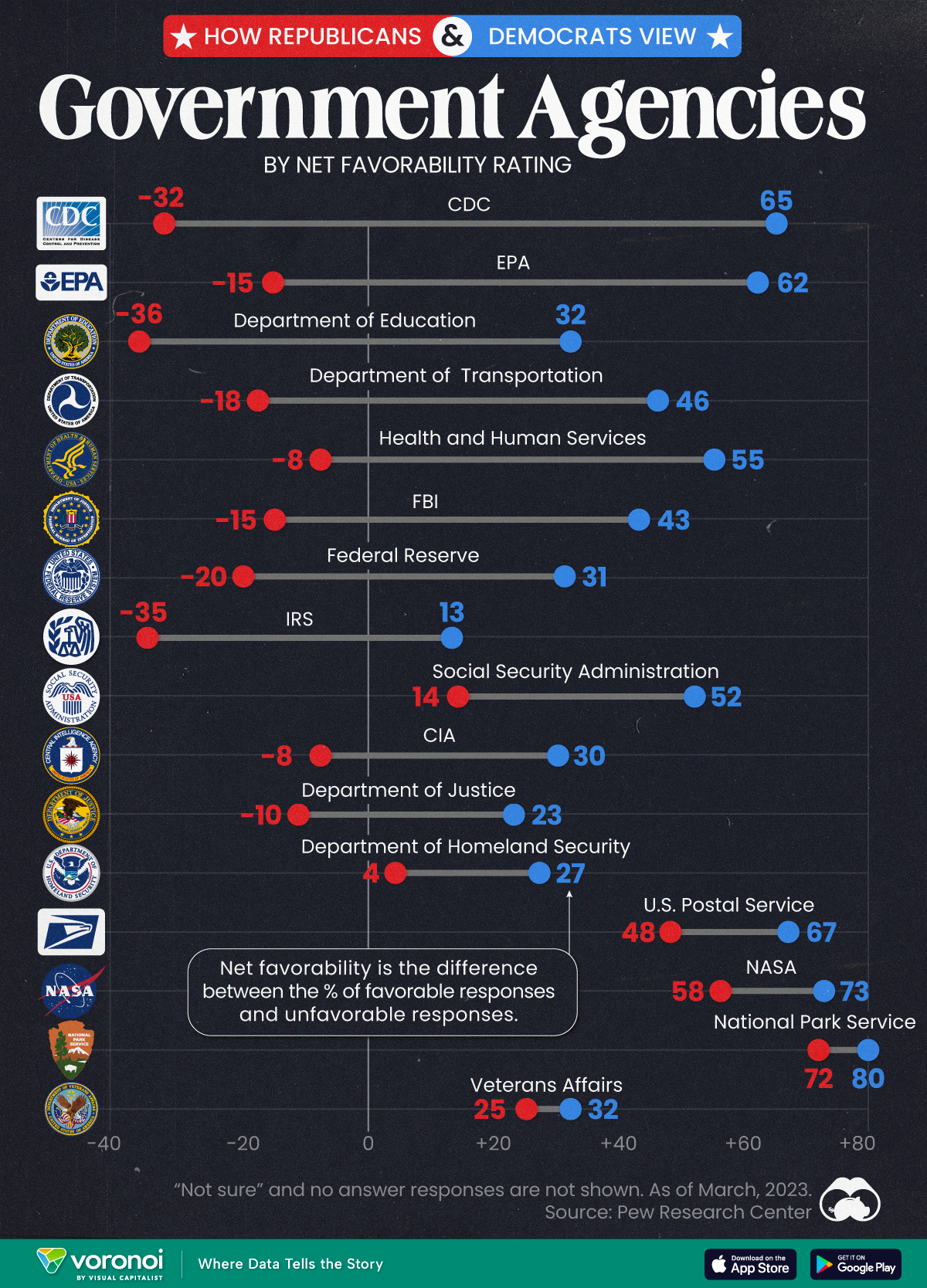Misc
What Types of People Appear Most on International Currencies?

What Types of People Appear Most on International Currencies?
On currencies throughout the world, you’ll see everything from revolutionaries to poets featured prominently. But how does this mix of notable people break down quantitatively?
This graphic by NetCredit shows the types of people, by their main occupations and roles, that are featured on banknotes and coins worldwide.
Global Money Features Power
To find out the types of people most featured on money, NetCredit analyzed all the banknotes and coins in circulation in every country across the globe in 2022.
From monarchs to athletes, the analysis found that many types of people appear on banknotes and coins worldwide. In fact, 51 different main occupations and roles were identified, which were then organized into eight overarching categories:
- Leadership
- Government
- Society
- Sport & Recreation
- Military & Espionage
- Religion
- The Arts
- Humanity
Here’s a breakdown of all 51 different occupations, and what percentage of worldwide currencies they’re featured on:
| Occupation | Category | % on Currencies |
|---|---|---|
| Monarch | Leadership | 30.24% |
| Head of government | Government | 20.74% |
| Politician | Government | 10.03% |
| Military | Military & Esionage | 8.22% |
| Poet | The Arts | 5.13% |
| Religious leader | Religion | 3.02% |
| Author | The Arts | 2.26% |
| Artist | The Arts | 1.73% |
| Writer | The Arts | 1.51% |
| Musician | The Arts | 1.51% |
| Activist | Society | 1.28% |
| Scientist | Science & Humanities | 1.21% |
| Movement leader | Leadership | 0.98% |
| Saint | Religion | 0.98% |
| Explorer | Science & Humanities | 0.90% |
| Inventor | Science & Humanities | 0.83% |
| Scholar | Science & Humanities | 0.83% |
| Revolutionary | Leadership | 0.60% |
| Business | Society | 0.60% |
| Hero | Society | 0.60% |
| Athlete | Sport & Recreation | 0.60% |
| Supreme leader | Leadership | 0.53% |
| Educator | Science & Humanities | 0.53% |
| Historian | Science & Humanities | 0.45% |
| Singer | The Arts | 0.45% |
| Nationalist leader | Leadership | 0.38% |
| Doctor | Science & Humanities | 0.38% |
| Mathematician | Science & Humanities | 0.38% |
| Chief | Leadership | 0.30% |
| Architect | Science & Humanities | 0.30% |
| Economist | Science & Humanities | 0.30% |
| Philosopher | Science & Humanities | 0.23% |
| Actor | The Arts | 0.23% |
| Chief of state | Government | 0.15% |
| Revolutionary leader | Leadership | 0.15% |
| Intellectual | Science & Humanities | 0.15% |
| Lawyer | Science & Humanities | 0.15% |
| Wife | Society | 0.15% |
| Spy | Military & Esionage | 0.08% |
| Rector | Religion | 0.08% |
| Civil engineer | Science & Humanities | 0.08% |
| Linguist | Science & Humanities | 0.08% |
| Philanthropist | Science & Humanities | 0.08% |
| Anthropologist | Science and Humanities | 0.08% |
| Social worker | Society | 0.08% |
| Ballerina | Sport & Recreation | 0.08% |
| Chess champion | Sport & Recreation | 0.08% |
| Mountaineer | Sport & Recreation | 0.08% |
| Actress | The Arts | 0.08% |
| Film director | The Arts | 0.08% |
The analysis shows that over 50% of the people featured on money are either monarchs or heads of government, many of which are no longer in power.
For instance, Belize was once a British colony and still features the late Elizabeth II on all of its currency—even though the country gained independence from the UK in 1981.
And everyone featured on U.S. currency is also a historical figure. Putting living celebrities on U.S. money has been banned since 1866, after Spencer Clark, who was the Superintendent of the U.S. National Currency Bureau at the time, printed his own face on the 5-cent banknote instead of the explorer William Clark of “Lewis and Clark.”
International Currencies: The Most Popular Figure Heads
Featured on over 100 different currencies around the world, the late Elizabeth II is the most featured person on banknotes and coins.
This makes sense considering the UK’s widespread historical reach. During the height of its reign in the early 20th century, the British Empire ruled nearly a quarter of the world.

Perhaps unsurprisingly, 6 of the top 10 most-featured people on currencies are monarchs, while the rest are heads of government.
Women on Banknotes
While Elizabeth II is the most featured person on currencies around the world, it’s worth mentioning that few other women have been given the same honor.
A study analyzed 1,006 current international banknotes and found that only 15% featured images of women.
However, some countries are actively trying to celebrate more women on their money. For example, the U.S. has been planning to put Harriet Tubman on the U.S. $20 bill for years, and while there have been some delays, the bill is currently on track to get released by 2030.

This article was published as a part of Visual Capitalist's Creator Program, which features data-driven visuals from some of our favorite Creators around the world.
Public Opinion
Charted: How Democrats and Republicans View Government Agencies
Predictably, results diverge when both Democrats and Republicans are asked to rate key government agencies in the United States.

How Democrats and Republicans View Government Agencies
This was originally posted on our Voronoi app. Download the app for free on iOS or Android and discover incredible data-driven charts from a variety of trusted sources.
Forget the presidential race, the partisan divide in America can also be seen by how Democrats and Republicans feel about key government agencies.
We visualize the net favorability ratings of 16 federal government agencies, based on respondent party affiliation.
To find this data, Pew Research Center surveyed more than 10,000 adults, between March 13-19, 2023. View their methodology page for more details about the survey, the questions asked, and the results obtained.
Republicans Don’t Like How the CDC Handled the Pandemic
The division in net favorability is deepest for three federal government agencies. While the CDC garnered a net favorability rating of 65 from Democrats, more Republicans rated the agency unfavorably, leading to a net favorability rating of -32.
Similarly, with the EPA and the Department of Education, the difference in net favorability between the two voting sides is as high as 70–80 points.
| Federal Agency | Republican Net Favorability Rating | Democrat Net Favorability Rating |
|---|---|---|
| 🔬 CDC | -32 | 65 |
| 🌿 EPA | -15 | 62 |
| 📚 Department of Education | -36 | 32 |
| 🚗 Department of Transportation | -18 | 46 |
| 💉 Health and Humans Services | -8 | 55 |
| 💰 Federal Reserve | -20 | 31 |
| 🕵️ FBI | -15 | 43 |
| 💼 IRS | -35 | 13 |
| 💼 Social Security Admin | 14 | 52 |
| 🕵️♂️ CIA | -8 | 30 |
| ⚖️ Justice Department | -10 | 23 |
| 🛡️ Homeland Security | 4 | 27 |
| 📮 USPS | 48 | 67 |
| 🚀 NASA | 58 | 73 |
| 🏞️ Park Service | 72 | 80 |
| 🎖️ Veterans Affairs | 25 | 32 |
Pew Research Center notes that Republicans didn’t always view the CDC quite so unfavorably, though a direct comparison is impossible.
Nevertheless, per the source, in March 2020, 84% of surveyed Republicans expressed positive views of the CDC’s performance. By October 2022, just 32% said the CDC had done an excellent or good job of handling the pandemic.
Meanwhile, there are a few agencies the two sides do agree on: the National Park Service, the Postal Service, and NASA.
And they both agree on Veterans Affairs as well: though neither share a particularly high opinion of the organization.
Finally, Democrats consistently rate all sixteen agencies on the survey more favorably than Republicans, showing consistency about how each side views the government in general.
-

 Maps7 days ago
Maps7 days agoMapped: Southeast Asia’s GDP Per Capita, by Country
-

 Markets2 weeks ago
Markets2 weeks agoVisualizing Global Inflation Forecasts (2024-2026)
-

 United States2 weeks ago
United States2 weeks agoCharted: What Southeast Asia Thinks About China & the U.S.
-

 United States2 weeks ago
United States2 weeks agoThe Evolution of U.S. Beer Logos
-

 Healthcare1 week ago
Healthcare1 week agoWhat Causes Preventable Child Deaths?
-

 Energy1 week ago
Energy1 week agoWho’s Building the Most Solar Energy?
-

 Markets1 week ago
Markets1 week agoMapped: The Most Valuable Company in Each Southeast Asian Country
-

 Technology1 week ago
Technology1 week agoMapped: The Number of AI Startups By Country















